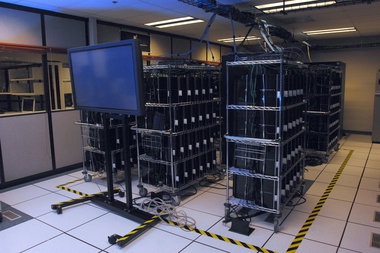Ah hahahaha!!!!
Windows! Some dumbass put Windows on a supercomputer!
From Wikipedia, the free encyclopedia
Linux is a family of open source Unix-like operating systems based on the Linux kernel, an operating system kernel first released on September 17, 1991 by Linus Torvalds. Linux is typically packaged in a Linux distribution (or distro for short).
Distributions include the Linux kernel and supporting system software and libraries, many of which are provided by the GNU Project. Many Linux distributions use the word "Linux" in their name, but the Free Software Foundation uses the name GNU/Linux to emphasize the importance of GNU software, causing some controversy.
Community icon by Alpár-Etele Méder, licensed under CC BY 3.0
Ah hahahaha!!!!
Windows! Some dumbass put Windows on a supercomputer!
Prob Microsoft themselves
Probably need one, just for the benchmark comparisons.
So basically, everybody switched from expensive UNIX™ to cheap "unix"-in-all-but-trademark-certification once it became feasible, and otherwise nothing has changed in 30 years.
Except this time the Unix-like took 100% of the market
Was too clear this thing is just better
Wait what Mac?
The Big Mac. 3rd fastest when it was built and also the cheapest, costing only $5.2 million.
Interesting. It's like those data centers that ran on thousands of Xboxes
Wha?
(searches interwebs)
Wow, that completely passed me by...
I think it was PS3 that shipped with "Other OS" functionality, and were sold a little cheaper than production costs would indicate, to make it up on games.
Only thing is, a bunch of institutions discovered you could order a pallet of PS3's, set up Linux, and have a pretty skookum cluster for cheap.
I'm pretty sure Sony dropped "Other OS" not because of vague concerns of piracy, but because they were effectively subsidizing supercomputers.
Don't know if any of those PS3 clusters made it onto Top500.
It was 33rd in 2010:
In November 2010, the Air Force Research Laboratory created a powerful supercomputer, nicknamed the "Condor Cluster", by connecting together 1,760 consoles with 168 GPUs and 84 coordinating servers in a parallel array capable of 500 trillion floating-point operations per second (500 TFLOPS). As built, the Condor Cluster was the 33rd largest supercomputer in the world and was used to analyze high definition satellite imagery at a cost of only one tenth that of a traditional supercomputer.
https://en.wikipedia.org/wiki/PlayStation_3_cluster

https://phys.org/news/2010-12-air-playstation-3s-supercomputer.html
Oh Xserve, we hardly knew ye 😢
Mac is a flavor of Unix, not that surprising really.
Mac is also also derived from BSD since it is built on Darwin
So you're telling me that there was a Mac super computer in '05?
https://en.wikipedia.org/wiki/System_X_(supercomputer)
G5
Oof, in only a couple years it was worthless.
Also known as Big Mac
haha
If I recall correctly they linked a bunch of powermacs together with FireWire.
Surprised to learn that there were windows based Supercomputers.
Those were the basic entry level configurations needed to run Windows Vista with Aero effects.
As someone who worked on designing racks in the super computer space about 10 q5vyrs ago I had no clue windows and mac even tried to entered the space
about 10 q5vyrs ago
Have you been distracted and typed a password/PSK in the wrong field 8)
Lol typing on phone plus bevy. Can't defend it beyond that
There was a time when a bunch of organisations made their own supercomputers by just clustering a lot of regular computers:
https://en.wikipedia.org/wiki/System_X_(supercomputer)
For Windows I couldn't find anything.
If you google "Windows supercomputer", you just get lots of results about Microsoft supercomputers, which of course all run on Linux.
No there was HPC sku of Windows 2003 and 2008 : https://en.m.wikipedia.org/wiki/Windows_Server_2003#Windows_Compute_Cluster_Server
Microsoft earnestly tried to enter the space with a deployment system, a job scheduler and an MPI implementation. Licenses were quite cheap and they were pushing hard with free consulting and support, but it did not stick.
Wow, that's kind of a lot more Linux than I was expecting, but it also makes sense. Pretty cool tbh.
Now the real question is what package manager are they using? apt or yum? Lol
I saw the thumbnail and thought this was a map of The Netherlands
Would the one made out of playstations be in this statistic?
I think you can actually see it in the graph.
The Condor Cluster with its 500 Teraflops would have been in the Top 500 supercomputers from 2009 till ~2014.
The PS3 operating system is a BSD, and you can see a thin yellow line in that exact time frame.
What would the other be
TempleOS
When you really have to look deep into god's mind you just have to put templeOS on a supercomputer.
Maybe windows is not used in supercomputers often because unix and linux is more flexiable for the cpus they use(Power9,Sparc,etc)
Plus Linux doesn't limit you in the number of drives, whereas Windows limits you from A to Z. I read it here.
"Is your UNIX Linux compatible?"